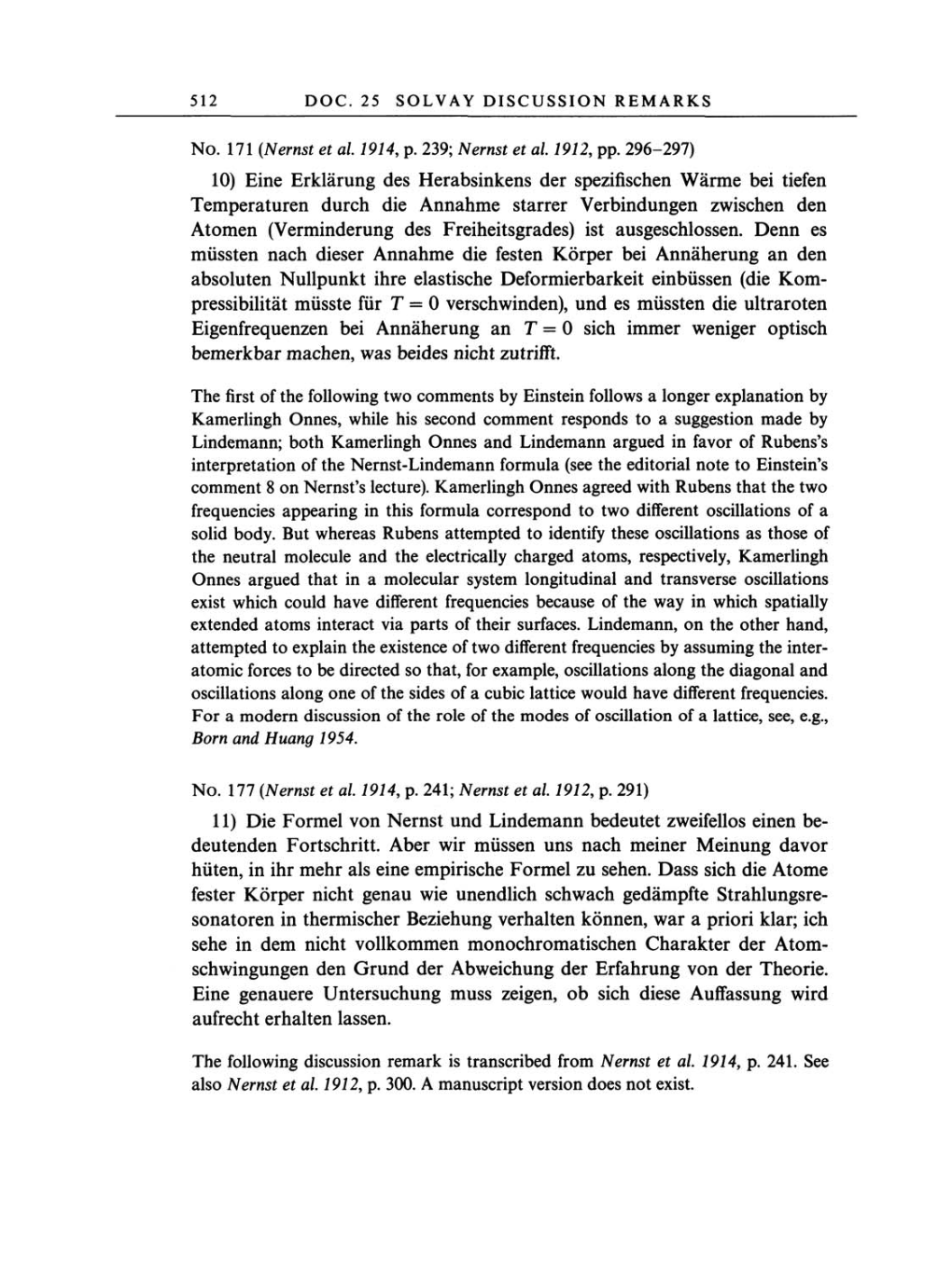512
DOC.
25
SOLVAY DISCUSSION REMARKS
No.
171 (Nernst et al.
1914,
p.
239;
Nernst
et al.
1912, pp.
296-297)
10)
Eine
Erklärung
des
Herabsinkens
der
spezifischen
Wärme
bei tiefen
Temperaturen
durch
die
Annahme
starrer Verbindungen
zwischen den
Atomen
(Verminderung
des
Freiheitsgrades)
ist
ausgeschlossen.
Denn
es
müssten nach
dieser Annahme
die festen
Körper
bei
Annäherung an
den
absoluten
Nullpunkt
ihre
elastische
Deformierbarkeit
einbüssen
(die
Kom-
pressibilität
müsste für T
=
0
verschwinden),
und
es
müssten
die
ultraroten
Eigenfrequenzen
bei
Annäherung
an
T
=
0 sich
immer
weniger optisch
bemerkbar
machen,
was
beides
nicht zutrifft.
The
first
of
the following two comments by
Einstein
follows
a
longer
explanation
by
Kamerlingh
Onnes,
while his
second
comment responds
to
a
suggestion
made
by
Lindemann;
both
Kamerlingh
Onnes and Lindemann
argued
in favor of Rubens's
interpretation
of the Nernst-Lindemann
formula
(see
the editorial
note to
Einstein's
comment
8 on
Nernst's
lecture).
Kamerlingh
Onnes
agreed
with Rubens
that
the
two
frequencies appearing
in
this
formula
correspond
to two
different oscillations of
a
solid
body.
But whereas
Rubens
attempted
to
identify
these
oscillations
as
those of
the neutral
molecule and the
electrically charged atoms, respectively, Kamerlingh
Onnes
argued
that
in
a
molecular
system longitudinal
and
transverse
oscillations
exist
which
could have different
frequencies
because of the
way
in which
spatially
extended
atoms
interact via
parts
of their
surfaces. Lindemann,
on
the other
hand,
attempted
to
explain
the existence of
two
different
frequencies by assuming
the inter-
atomic forces
to be
directed
so
that,
for
example,
oscillations
along
the
diagonal
and
oscillations
along
one
of the
sides
of
a
cubic lattice would have different
frequencies.
For
a
modern discussion
of the role
of the
modes of oscillation of
a
lattice,
see, e.g.,
Born
and
Huang
1954.
No.
177
(Nernst et
al.
1914,
p.
241;
Nernst
et
al.
1912,
p.
291)
11)
Die Formel
von
Nernst und Lindemann bedeutet
zweifellos
einen
be-
deutenden
Fortschritt. Aber wir müssen
uns
nach meiner
Meinung
davor
hüten,
in ihr mehr
als eine
empirische
Formel
zu
sehen.
Dass
sich die
Atome
fester
Körper
nicht
genau
wie
unendlich schwach
gedämpfte Strahlungsre-
sonatoren
in thermischer
Beziehung
verhalten
können,
war a priori
klar;
ich
sehe
in dem nicht
vollkommen
monochromatischen
Charakter
der Atom-
schwingungen
den
Grund
der
Abweichung
der
Erfahrung
von
der Theorie.
Eine
genauere Untersuchung
muss zeigen,
ob
sich diese
Auffassung
wird
aufrecht erhalten lassen.
The
following
discussion remark
is
transcribed from Nernst
et al.
1914,
p.
241. See
also Nernst
et
al.
1912,
p.
300.
A
manuscript
version does not
exist.
